
Ridgeheads, also known as bigscales, are a family of small, deep-sea stephanoberyciform fish. The family contains approximately 37 species in five genera; their distribution is worldwide, but ridgeheads are absent from the Arctic Ocean and Mediterranean Sea. Although the family is one of the most widespread and plentiful of deep-sea families, none of its members are of interest to commercial fishery.

The family Torpedinidae contains 22 species of electric rays or torpedoes, flat cartilaginous fishes that produce electricity as a defense and feeding mechanism. They are slow-moving bottom-dwellers.

Cottus is a genus of the mainly freshwater ray-finned fishes belonging to the family Cottidae, the typical sculpins. They are often referred to as the "freshwater sculpins", as they are the principal genus of sculpins to be found in fresh water. They are native to the Palearctic and Nearctic.

Gymnothorax is a genus of fish in the family Muraenidae found in Atlantic, Indian and Pacific Ocean. With more than 120 species, it the most speciose genus of moray eels.
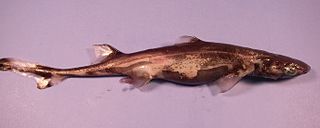
Etmopterus is a genus of lantern sharks in the squaliform family Etmopteridae. They are found in deep sea ecosystems of the Atlantic, Indian and Pacific Oceans.

Sargocentron is a genus of squirrelfish found in tropical parts of the Indian, Pacific and Atlantic Oceans, with the greatest species diversity near reefs in the Indo-Pacific. Being largely or entirely nocturnal, they have relatively large eyes. Red and silvery colours dominate. The preopercle spines are venomous and can give painful wounds. Most have a maximum length of 15–25 cm (6–10 in), but S. iota barely reaches 8 cm (3 in), and S. spiniferum can reach more than 50 cm (20 in).
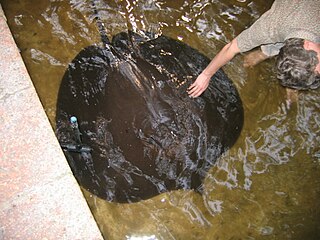
The giant freshwater stingray is a species of stingray in the family Dasyatidae. It is found in large rivers and estuaries in Southeast Asia and Borneo, though historically it may have been more widely distributed in South and Southeast Asia. The largest freshwater fish and the largest stingray in the world, this species grows up to 2.2 m (7.2 ft) across and can reach up to 300 kg (660 lb) in weight. It has a relatively thin, oval pectoral fin disc that is widest anteriorly, and a sharply pointed snout with a protruding tip. Its tail is thin and whip-like, and lacks fin folds. This species is uniformly grayish brown above and white below; the underside of the pectoral and pelvic fins bear distinctive wide, dark bands on their posterior margins.

Polylepis is a genus comprising 28 recognised shrub and tree species, that are endemic to the mid- and high-elevation regions of the tropical Andes. This group is unique in the rose family in that it is predominantly wind-pollinated. They are usually gnarled in shape, but in certain areas some trees are 15–20 m tall and have 2 m-thick trunks. The foliage is evergreen, with dense small leaves, and often having large amounts of dead twigs hanging down from the underside of the canopy. The name Polylepis is, in fact, derived from the Greek words poly (many) plus letis (layers), referring to the shredding, multi-layered bark that is common to all species of the genus. The bark is thick and rough and densely layered for protection against low temperatures. Some species of Polylepis form woodlands growing well above normal tree line within grass and scrub associations at elevations over 5000 m; which makes Polylepis appear to be the highest naturally occurring arboraceous angiosperm genus in the world.

Cobitis is a genus of small freshwater fish in the family Cobitidae from temperate and subtropical Eurasia. It contains the "typical spiny loaches", including the well-known spined loach of Europe. Similar spiny loaches, occurring generally south of the range of Cobitis, are nowadays separated in Sabanejewia.

Moxostoma, the redhorses or jumprocks, is a genus of North American ray-finned fish in the family Catostomidae. Redhorses are variable in size, geographic location, and other ecological traits such as spawning substrate. Several redhorses are long-lived, much like many other catostomid species. The silver redhorse is the longest-lived redhorse known by nearly a decade, with ages exceeding 40 years. Redhorses are broadly of conservation concern, as these long-lived species are highly intolerant to environmental pollution, habitat fragmentation, and are currently subject to unregulated 21st century sport bowfishing which is removing and wantonly wasting several of these species by the ton.
Photonectes is a genus of fish in the family Stomiidae found in Atlantic, Indian and Pacific Ocean.

Poromitra crassiceps, commonly called the crested bigscale is a species of deep sea fish in the ridgehead family.

Poromitra is a genus of ridgeheads. The 22 known species of Poromitra have been divided into five species groups according to variation in preopercle anatomy.
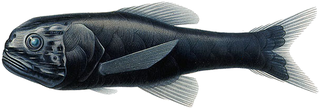
Scopelogadus is a genus of ridgeheads. The generic name derives from the Greek σκόπελος and γάδος.

Zanclorhynchus is a genus of marine ray-finned fishes belonging to the family Congiopodidae, the pigfishes or horsefishes. These fishes are found in the Southern Ocean.

Caristius is a genus of manefishes native to the Atlantic and Pacific Oceans.
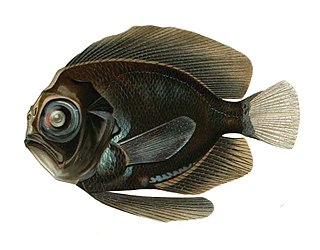
Platyberyx is a genus of manefishes native to the eastern Atlantic Ocean.
John Ernest "Jack" Randall was an American ichthyologist and a leading authority on coral reef fishes. Randall described over 800 species and authored 11 books and over 900 scientific papers and popular articles. He spent most of his career working in Hawaii. He died in April 2020 at the age of 95.
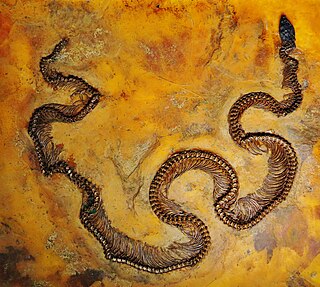
Eoconstrictor is an extinct genus of booid snake, which supposedly had infrared vision, from the Eocene of Germany. The type species, E. fischeri is known from multiple well-preserved specimens found in the Messel Pit of Germany. It was originally named as Palaeopython fischeri by Stephan Schaal in 2004, but examination of the genus showed that it represented a distinct lineage; it was renamed as the new genus Eoconstrictor in 2020. In a subsequent study Georgalis, Rabi & Smith (2021) reinterpreted "Paleryx" spinifer from the Eocene Geiseltal Lagerstätte as the second species species belonging to the genus Eoconstrictor. Palci et al. (2023) named the third species belonging to this genus, E. barnesi described on the basis of fossils from the Geiseltal Lagerstätte.
Lycozoarces is a monospecific genus of marine ray-finned fish belonging to the family Zoarcidae, the eelpouts, its only species being Lycozoarces regani. It is the only genus in the monogeneric subfamily Lycozoarinae. This taxon occurs in the northwestern Pacific Ocean in the Sea of Okhotsk and the Tatar Strait in the northern Sea of Japan


















